
I feel extremely lucky to have got the chance to work in Johns garden at Ashwood Nurseries, what a fantastic experience! The garden is a feast for the senses, filled with a vast collection of choice plants which create interest every day of the year. It is truly a plant person’s paradise.
The gardens bones are created from expertly pruned trees, John calls this ‘Transparency pruning’ and its importance has been explained to me since my very first day. The idea is that the trees are carefully pruned to allow more light to filter through the canopy, which then creates the perfect planting opportunity underneath.
January – My first week at Ashwood began at the end of January. At this time of year the Hamamelis in the front garden are really starting to put on a show, shades of orange, red and yellow stand out against the crisp winter sky and the scent is simply amazing! Hamamelis mollis ‘Wisley Supreme’ is a really good performer, it flowers reliably on Christmas day and has a great scent.
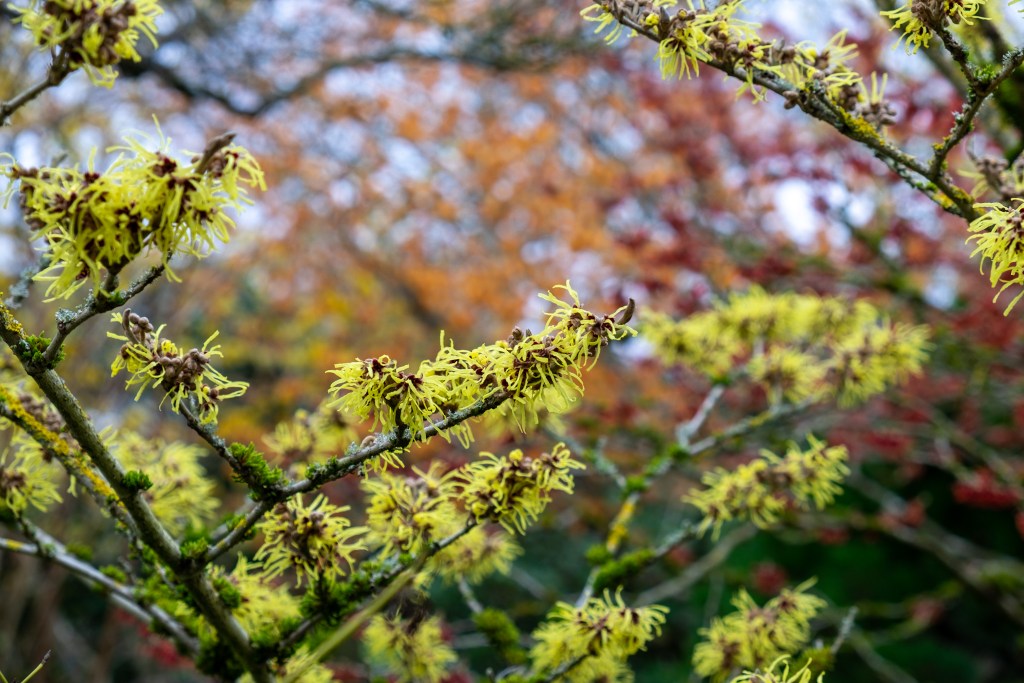
Hamamelis in the front garden
One of my first jobs was pruning the Podocarpus (Plum pine) in the front garden. The aim was to reduce the extension growth whilst ensuring that the pruning cuts were hidden as best as possible, so that they looked untouched. The stems were cleaned up and any suckers removed to really show off that attractive bark and expose the structure. Podocarpus look magical on a frosty morning in the winter.
Mark Harvey, who is a conifer expert, came in and gave us a Masterclass on pruning conifers. He showed us how he would transform a Pinus mugo ‘Wintergold’. The tree was beginning to get too wide and the canopy becoming too dense. He selectively pruned out branches to reduce the size of the tree. Lower branches were removed so that glimpses of the rest of the rock garden could be viewed. The rock garden is filled with some amazing conifer specimens. A couple of my favourites are Abies koreana ‘Kohouts Ice Breaker, Chamaecyparis lawsoniana ‘Wissels Saguaro’ and Pinus strobus ‘Louie’ to name a few.

Mark pruning a conifer
Some conifers needed moving in Adams garden as they weren’t quite in the right place. The process was digging a trench around the root ball and taking care not to disturb the root system. Then they were lifted and placed in the new location, firming in afterwards and watering in well. As these were still young trees they needed to be staked. When staking it needs to be pointing towards the prevailing wind, this is so that in strong gusts it is pushed into the ground rather than pulled out of it. The trees are secured with flexi twine in a figure of eight, this makes sure that the tree can’t rub against the stake and cause damage. An important job that needs doing throughout the year is checking the tree supports. Does it still need it?, is it doing its job?, is the twine cutting in or rubbing the tree?, has it outgrown it?
At this time of year leaf mould is added to the borders, it is an excellent free soil conditioner and its darker colour really makes winter flowering bulbs stand out.
February – Johns garden is alive with winter flowering plants, Snowdrops, Winter Aconites and Cyclamen coum carpet the ground while Iris reticulata add colour to the ever changing pot display. Hellebores are starting to perform all around the garden.

Iris reticulata on the patio
I would class myself as a bit of a Galanthophile and John’s garden definitely doesn’t disappoint. There is a huge collection of choice bulbs which are an absolute joy to see. Nigel explained to me how choice snowdrops should be moved in June when they are dormant and not when they are in the green, this is because snowdrop roots are annual, so this risks causing damage to them which could then lead to problems. He also recommended that after flowering when the foliage is dying back they should be fed weekly with tomato feed to encourage the bulbs to bulk up.
We carry on with pruning in the garden and start with the large Abies concolor, it has developed a second leader which looks unsightly and is starting to affect the overall growth of the tree. This was removed with a long reach pruning saw, taking our time, section by section to remove the weight from the branch before doing the final clean cut.
There is a large rambling rose called Francis E. Lester which covers a building just behind John’s garden. This needed a renovation prune as it was getting too big. Any dead or diseased branches were removed and then any whippy growth was cut back to the main framework. The branches were then bent down and tied in as this encourages more flowering.
When Mark came in January he, along with John and Nigel, decided which conifers should be removed. These were selected for either being poorly performing specimens or being too close to other plants. This was one of my jobs to cut down and remove some of these which in turn opened up the view and allowed for new planting opportunities.
I got the opportunity to attend a Hellebore tour which was extremely interesting. I learnt about how the plants are grown for sale and the reason why John selected Hellebores to breed.
At this time of year, the pot display is a bit more challenging as we are limited to what plants we can use but it gives a welcome splash of colour and shows that spring is well on its way.
The Nursery and John’s garden have been approached by the Gardeners World Live team to exhibit at the show in June. The idea is that the show garden is going to be split into 3 different areas, one of which is going to represent the Christopher Lloyd bed. So we have to ensure that we have enough plants, this means taking cuttings and potting on some plants ready for the show. Cuttings of lots of varieties of Plectranthus, Tradescantia and Iresine’s were taken for the display. The cuttings were taken with a sharp pair of snips under a node, then lower down leaves were removed and the growing point taken out. Any large leaves were cut in half to reduce the transpiration rate and then the cuttings were placed into a compost mix with a lot of perlite and firmed in well. Finally, they were watered and placed in a high humidity environment.
March – Spring is here. Narcissus are putting on a show, drifts of Narcissus cylamineus around the rock garden bob their heads in the breeze. Narcissus ‘Trena’ with its pale white flowers stand out against the intense orange from the Cornus behind. Hepatica are flowering like little jewels and John’s greenhouse is filled with colour!

Narcissus cylamineus

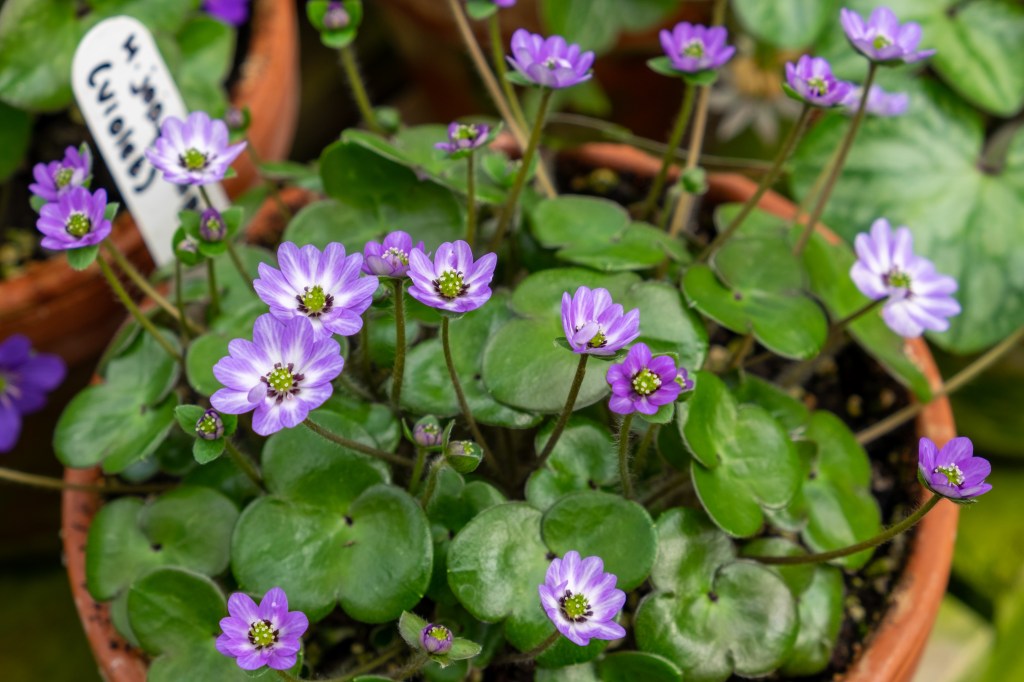

Hepatica in John’s greenhouse
The Salix (Willow) in the garden is pruned at this time of the year. Rather than the plants being cut right back, the stems are thinned and weak growth is removed, this means that the colourful stems can be appreciated for longer and it’s not such an invasive process.
I attended the ‘Springing Forward into Spring’ Masterclass with Nigel and he talked about all of the plants that could bring interest to your garden at this time of year as well as the jobs that could be done.
The Hepaticas are in flower in John’s greenhouse and when the sun is out it’s the perfect time to do some pollinating. You choose two plants with similar colour or characteristics and breed them by ‘rubbing noses’. This means getting two flowers and rubbing them together so that the pollen is transferred. The plants crosses are written on a label and placed into the pot. Now is also the perfect time to tidy the plants. I worked through the pots removing any fallen petals and brown leaves using tweezers and sharp snips.
I got the chance to do some pricking out of Cyclamen on the nursery. The seedlings are placed into terracotta pans ensuring good spacing between each. First you carefully remove the seedlings from the seed tray making sure that the root isn’t damaged. Then add the soil mix to a pan and firm in, dib a hole and drag the seedlings roots across the soil and place into the hole, firming gently. I had to be particularly careful when doing Cyclamen graecum as these have deep tap roots which won’t recover if damaged.
Thinned the growth on the Pinus nigra ‘Bright eyes’ taking out any dead growth and some of the lower hanging branches.
One of my favourite days in March was working with Kevin on the Hellebores, Kevin is a true expert and has made Ashwood Hellebores the best available. I got shown the process of breeding the plants, this was removing the filament with the anthers attached using tweezers and rubbing the pollen on the stigma of the mother plant. The flowers on the mother plant that were to be fertilised were still closed, so the bud had to be carefully opened and pollinated. For the more specialist plants the anthers were removed from the mother plants with scissors to remove the possibility of self-pollination. Labels were then tied on the individual flowers to show which had been bred.
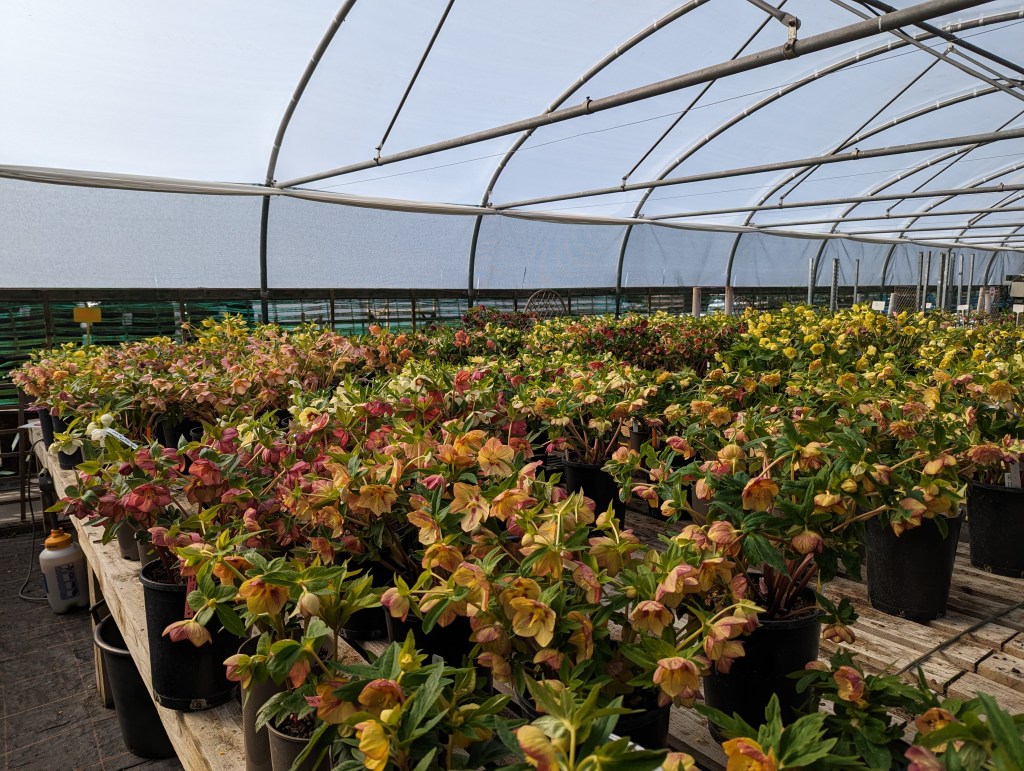
The Hellebore tunnel
Pruned the Hydrangea paniculata, first all of the growth was cut back slightly so it was easier to see the overall shape, any dead or weak growth was removed and then the shoots were taken back to 2 or 3 buds thinking about what the final shape is going to look like.
Now is a good time to be thinking about plant supports for the year ahead. Nigel showed me how to create supports using Hazel branches, once weaved together it’s amazing how strong these are. These will be perfect supports for the Solidago in Adams Garden.
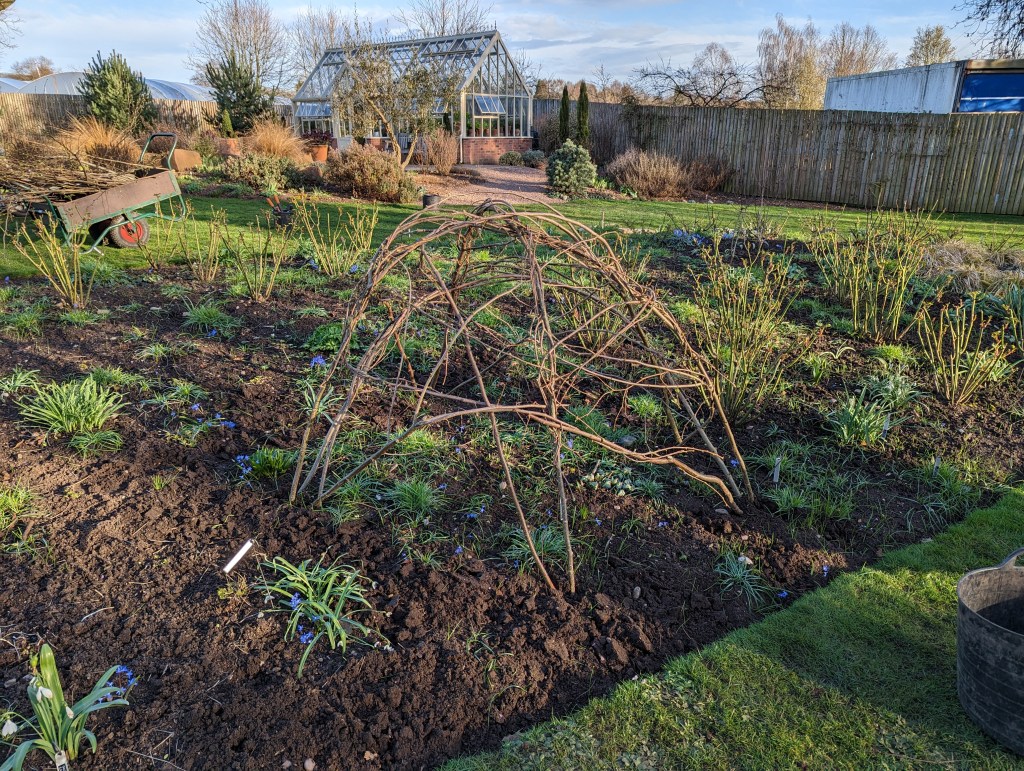
Hazel support
The grasses have done their job in the grass border providing structure throughout the winter and need to be cut down to allow the fresh new growth to burst through. We used shears to cut them into neat little mounds.
Due to the severity of the winter, like in most gardens, some plants were unfortunately lost. Although sad at the time, it does lead to change in the garden which can be a good thing. Most of the plants lost were in the Mediterranean garden so some of these are on the edge of being hardy as it is.
Worked through all of the Cornus in the garden cutting them down to two buds as it’s the new wood that has the strongest colour.
April – Fritillaria meleagris take over the show. Hundreds of purple and white flowers transform the Iris bed into a magical meadow. Anemone pavonina turn a grass bank in the front garden into a sea of colour. Tulips are popping in the pot display and around the garden.
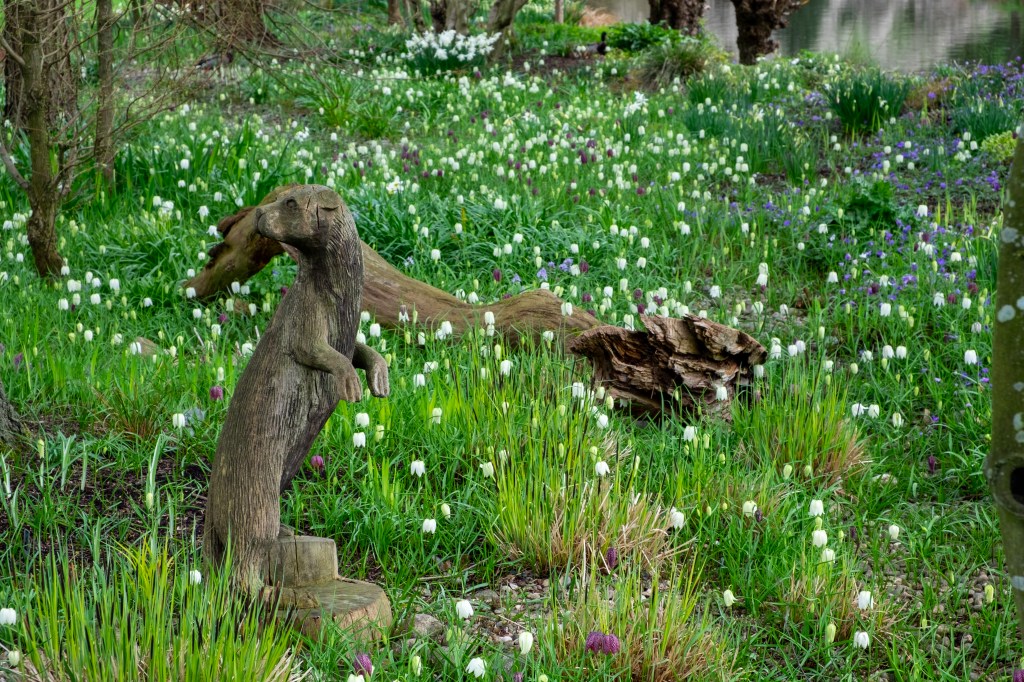
Fritillaria meleagris
Due to the conifer removal earlier in the year, this made space for new alpines on the rock garden. I planted a number of these including Sempervivum, Voila Corsica, Armeria, Silene, Gentiana and Primula.
Some new plants were also needed on the tufa outcrop near to John’s patio. This differs from the rock garden as the plants are growing in pure sand and some are even planted straight into the rock. Some lovely little choice alpines went into this including Androsace and Phlox douglasii ‘Zigeunerblut’ with its bright pink-red flowers.
The biggest job of the month was the border renovation of the Island bed. It needed renovation mainly because of a plant called Lysimachia nummularia (Creeping Jenny) which was starting to take over the bed, but it was also looking a bit flat. Everything was removed section by section and placed onto the lawn with plastic sheeting. The soil was improved by adding manure, Cars soil improver and calcified seaweed. All the plants that had been lifted had to be carefully checked for Creeping Jenny.
A Hosta called ‘Forbidden fruit’ was removed and placed under the Cornus controversa to create some ground cover. The Holly balls were removed as they were in bad condition. A fantastic Primula called ‘Snow Cushion’ was hiding most of the weeds, so these were lifted, checked through and ended up being divided into hundreds of plants before being placed back in. Two more Primulas worthy of a mention in the bed are ‘Dark Rosalean’ and ‘Feckenham Cream’.
Any bulbs that had been removed during the lifting process were placed back in (Corydalis, Snowdrops, Narcissus, Alliums). Hellebores were tidied and dotted through the border.
The rest of the plants in the bed were shifted around and new plants were added to give more interest and height to the border. Agastache ‘Black Adder’, Aster ‘Wunder von Stafa’ and Helenium ‘Moerheim Beauty’ being some of my favourites.

Renovation of the Island bed (Before)

(After)
After pollinating the Hepatica in March I was chuffed to see how successful the process had been. The flowers are now covered with small organza bags so that when the seeds ripen and fall off they will be caught. This was a fiddly job but one which I improved at as time went on. John showed me his method of sowing the collected seed. He explained how important it is to sow the seed fresh and that when it is released from the plant it has an immature embryo. Carefully firm the soil in the terracotta pans, sow the seeds individually with tweezers spacing accordingly, cover shallowly with grit and label, water three times letting the water rise to the top of the pan each time.
I love this time of year when the new fronds on ferns are starting to emerge. One thing that was done was removing the old foliage so that they are looking at their best. Another important job that needed to be done consistently was dead heading, particularly Hellebores, as if one is fertilized and a seed ends up germinating in the middle of the plant it can take over the parent.
May – Lewisia stand out in the display with their bright hues. Later in the month the Iris start to unfold in the Mediterranean garden. New growth appears on conifers with a fresh flush of colour.

Lewisia on the patio
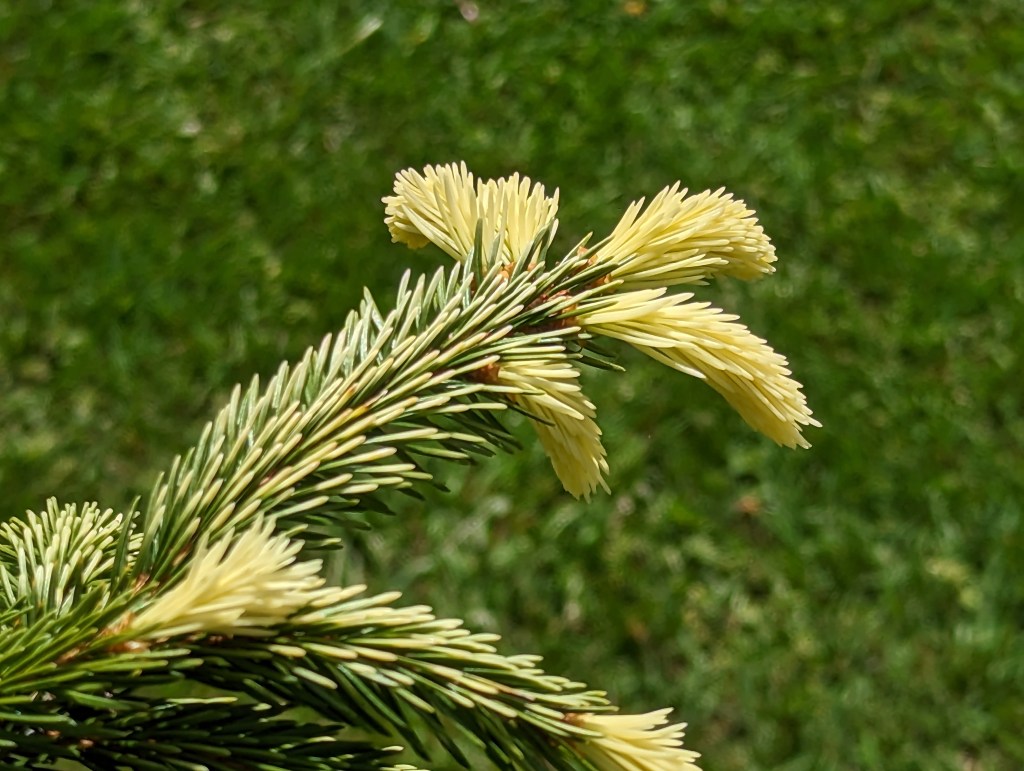

Picea abies ‘Argenteospicata’ and Picea abies ‘Rydal’
The Christopher Lloyd bed is one which is planted with tender plants and its design is different every year. This was one of my favourite jobs as I love working with tropical planting. The first thing that needed doing was the winter bedding needed stripping, this was comprised of Polyanthus and Tulips. Once this had been removed Nigel began to think about the layout of the bed and how the levels were going to work. Islands were created by mounding up the soil, wood stumps and branches were used to hold it back. Channels were dug between these to give the effect of a river flowing through the bed.
Now the exciting part, the planting! The largest went in first which was the huge Papyrus, Cyathea, Begonia luxurians and Shefflera, my favourite being macrophylla, the orange indumentum on the foliage is stunning, these added height to the bed. Then it was time to do the under planting which comprised of things like Hosta’s, Apidistra, Billbergia, Microlepia, Impatiens pseudoviola, Plectranthus and Phlebodium. The ‘river’ was created using various different Tradescantia, Begonia’s, Iresine herbstii and Hypoestes.
I think the final display is extremely impressive and it just shows what you can do with a relatively small area.
Christopher Lloyd bed (Before, during and after)

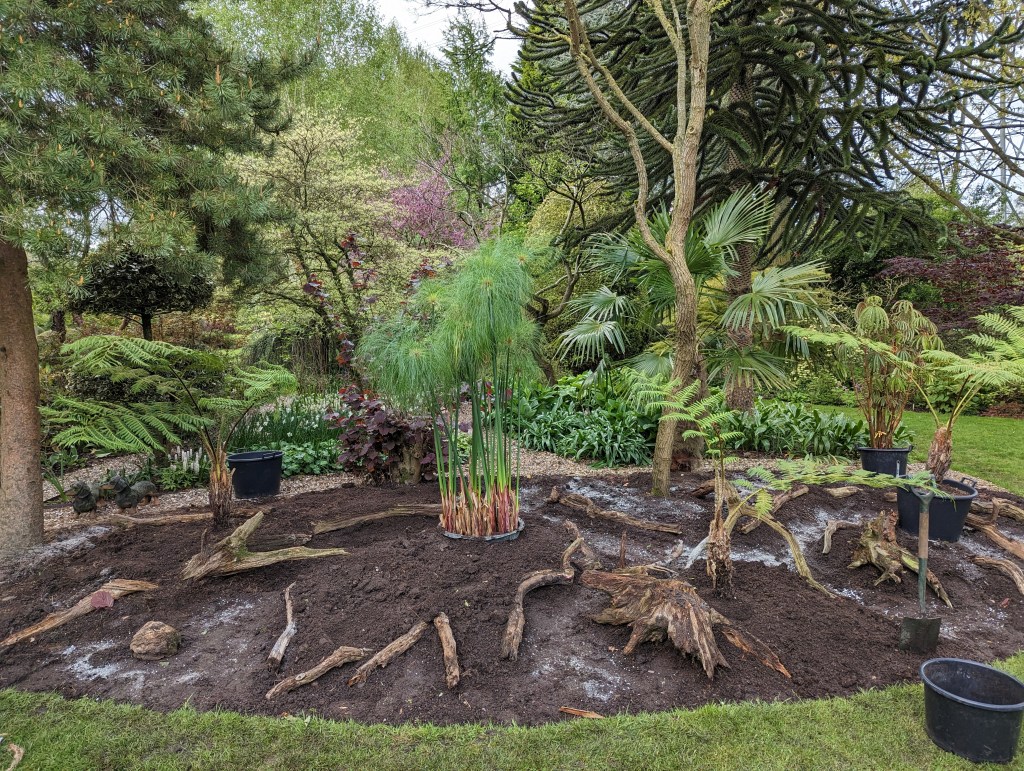
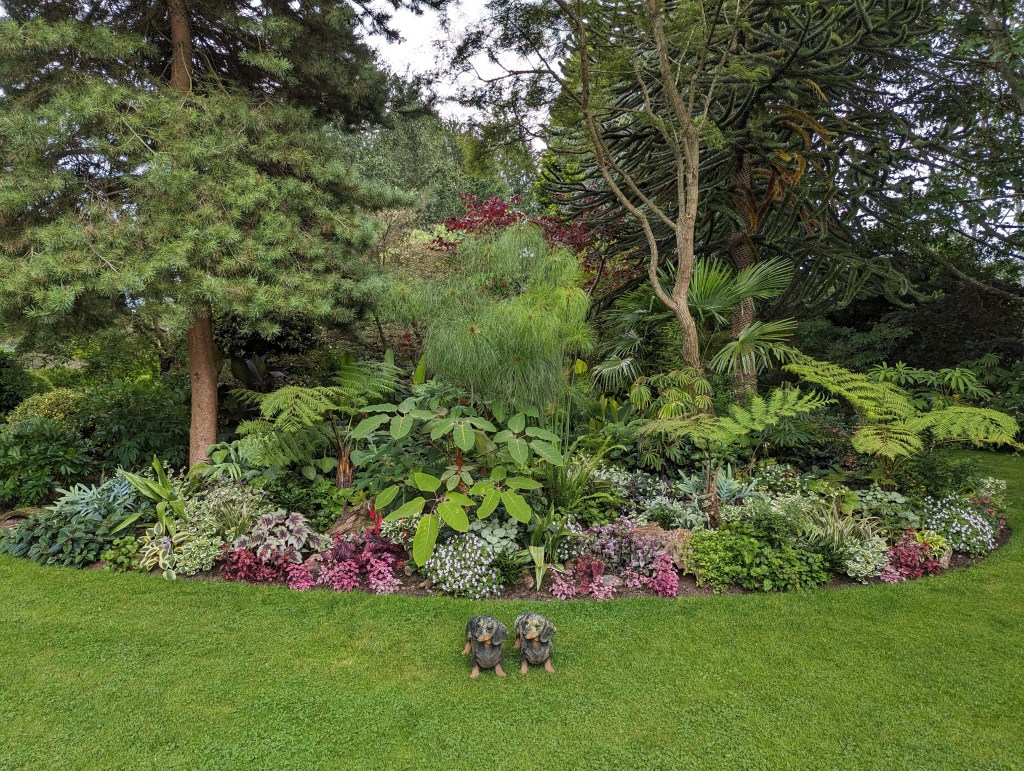
Another area which has a changing display is the Ruin garden. This area is framed by a stone Pergola and has raised areas supported by Tufa. The winter display had to be removed first, some plants were sent up to the nursery for sale and the others planted into the garden. We moved three large pots into the display and planted them up with Aeonium ‘Schwarzkopf’ to add height. An unusual shrub which I hadn’t come across before was used in the display called Grewia occidentalis, it originates from South Africa and has beautiful small purple flowers. The bulk of the display was filled using Pelargoniums which add to that Mediterranean feel.
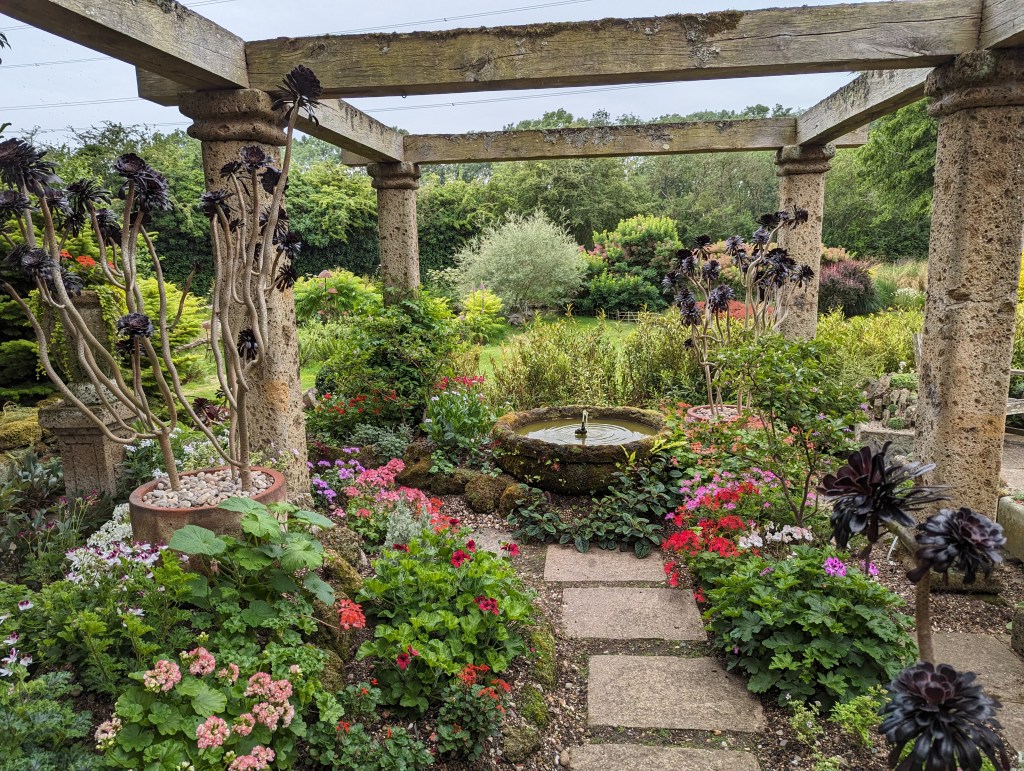
Ruin garden
The large containers in the garden are planted for the seasons so these need to be changed. I planted up the urn near the canal. The centre had Salvia ‘So cool Pale Blue’ with Pelargonium Choun cho, Lobelia, Calibrachoa and Scaevola surrounding it. This should look great when it gets going later in the year.
The urn in the front garden was planted with a selection of different fuchsias. The last pots I planted were two matching sets in the Mediterranean garden, I got to choose what went in these! For the smaller pots I selected Agave ‘Mediopicta Alba’ with Echeveria surrounding and the large pots Aeoniums with Aloe dawei, Echeveria and Curio repens.
June – Summer is here. Early in the month Cornus kousa are covered with flowers, I can imagine them taking flight like butterflies. The rest of the garden is bursting into life, Clematis are dripping with flowers and the roses in the garden are covered, their delicate scent is wafting around the garden.

Cornus kousa
I had the opportunity to get involved with the show garden at Gardeners World Live, this was a really interesting experience and I had never done anything like this before. As I mentioned earlier it was divided into 3 sections, the idea was to represent all of John’s garden. I helped with moving the metalwork into position and getting the feature trees in. These had been cleverly pruned to look like they had just been lifted from Johns garden. On the day of judging I helped go through the display with a fine tooth comb making sure everything was spot on. This involved dead heading plants, pruning out any dead or diseased material and ensuring that the pots were completely covered with bark so it wouldn’t detract from the display.
I felt privileged to be asked to represent the garden on one of the show days. I was at the forefront of the display and got to talk to people about the fantastic garden in which I work and answer people’s questions about the display.
Everyone’s hard work paid off and the garden got awarded a Platinum which is the highest available… Yipeee
Pictures from the show below.

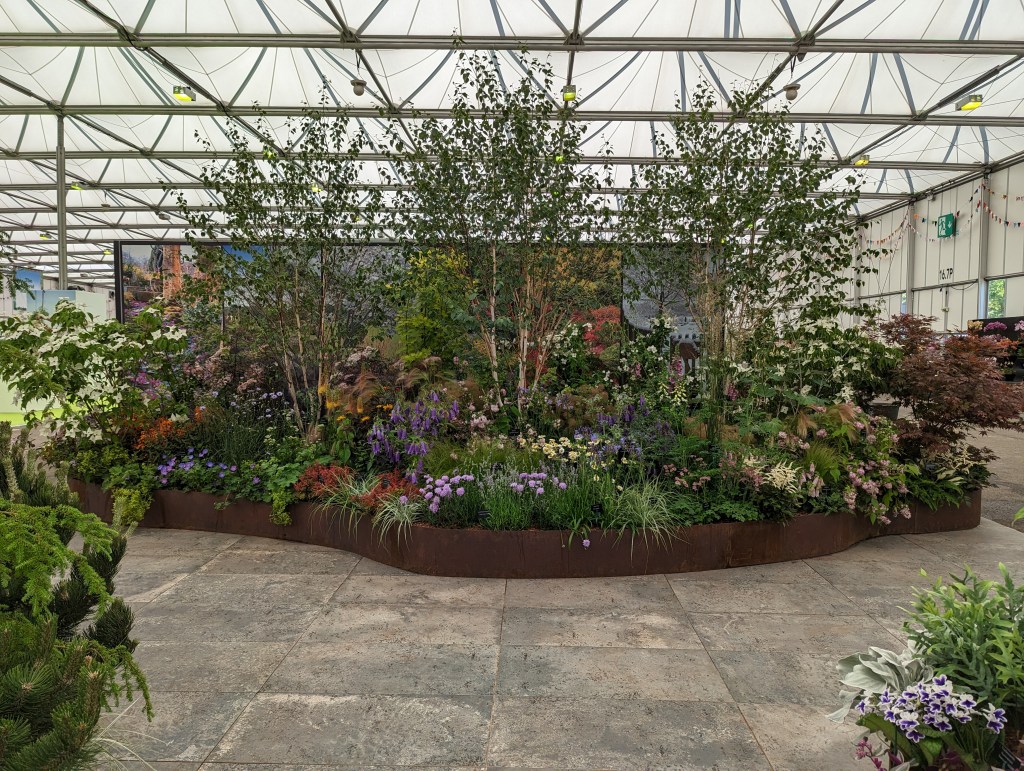

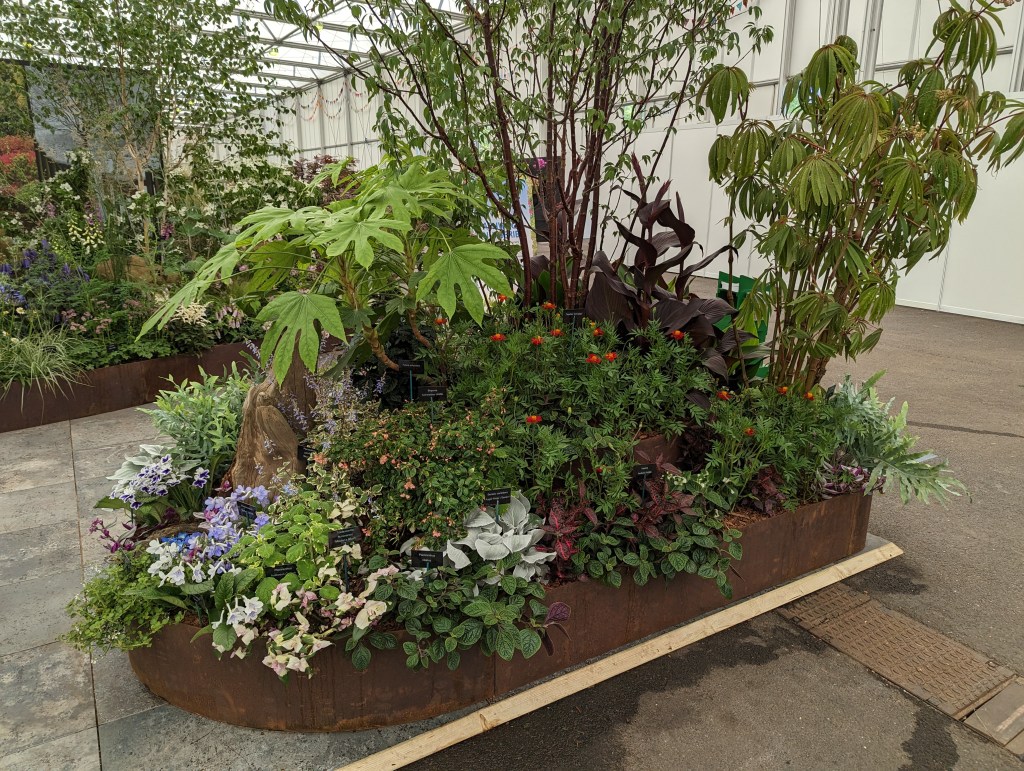
The whole experience was topped off by getting to meet one of my Horticultural hero’s, Carol Klein.
June is a time when plants will be putting on a lot of growth, so continuing to feed at this time of year will really benefit. We have a great devise called a Dosatron and I have used this a number of times to feed the Christopher Lloyd bed and the Ruin, it can be filled with any feed but we mainly use Maxicrop or tomato feed. Maxicrop for foliage, Tomato feed for flowering
The Woody Plant Committee visited and I got to spend the day with its extremely knowledgeable members. A particular highlight of mine was walking around the Wildlife garden with Roy Lancaster talking about wildflowers.
They even let me sit in on their meeting, I kept thinking about the amount of knowledge in that one room! What an experience.
A border will always change and it will never be 100 percent right first time. An example of this is in the Rye beds in Adams garden, as the year progresses you realize which plants aren’t performing as expected. Some of the plants needed to be changed, we replaced Geranium ‘Patricia’ with ‘Ivan’ and Kniphofia ‘Tawny King’ with ‘Fiery Fred’ as the plants that were in there just weren’t looking good enough. Plants were also added to bulk out the display such as Agastache ‘Red Fortune’ and ‘Geranium Red Admiral’
July – My final month working in John’s garden, I can’t believe how quick the time has gone! The garden is in full swing with so much interest it’s hard to take it all in. The Christopher Lloyd bed is looking marvellous after a flush of growth and the Iris bed is filled with pink clouds from the Astilbe.
Gert-Jan van der Kolk brought in some of his collection of ferns as he is moving abroad. A big job was working through the pots of Polypodiums and dividing them before potting up into a fresh compost. The rhizome was carefully teased apart and roots cleaned through before it was re potted and placed just underneath the soil surface. The pots will be kept under glass for a short while before being moved outside.
A Cercis canadensis ‘Forest Pansy’ had fallen down in the garden, it needed cutting into sections and the stump removing which took a while. Once it was removed Nigel thought it would be the perfect opportunity to plant some more of the ferns. The last of the ferns were planted into the front garden as it was looking a bit sparse at this time of year.
I was on the rota for working on a Saturday and this month saw my last one. It was great to welcome many visitors into the garden and talk about the planting as well as answering general gardening questions.
The Nepeta in Adams garden was starting to become a bit floppy so they were cut down into mounds, these will quickly regenerate and be flowering again later in the year.
The Box in the garden needed trimming to keep it looking tight, this was done with a sharp pair of shears. I used sheets around the plants so it was easier to clear up the waste. The plants were then sprayed with Top Buxus, this is a foliar feed which strengthens the plant making it less likely to have problems with Blight.
John asked me to have a look in the Wildlife garden, it was nice because I hadn’t had the chance to look there in a while. It was alive with insects, plants such as Knapweed, Mallow, Betonica officinalis, Toadflax and Glebionis providing pollen. It’s great to have a more relaxed area in the garden for yourself and wildlife.
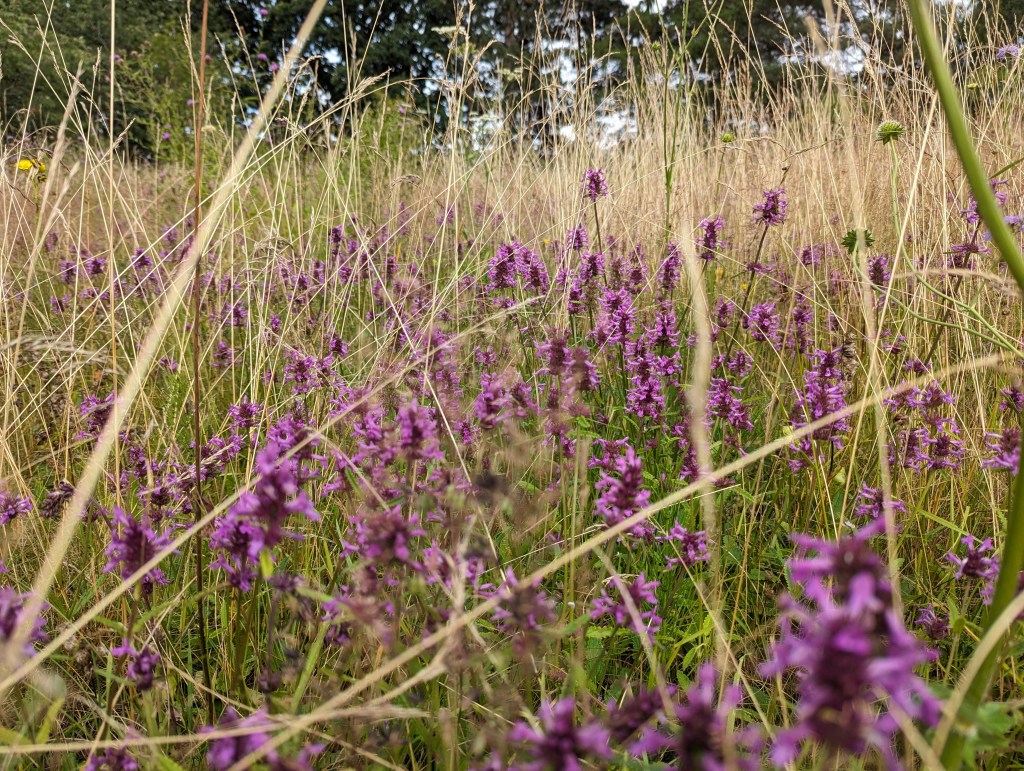
Betonica officinalis
I hope that this gives you a good flavour of what I got up to in my 6 months in John’s Garden. The garden is kept to an extremely high standard with weeding, deadheading, picking over and edging. I think it has to be the best kept garden anywhere!
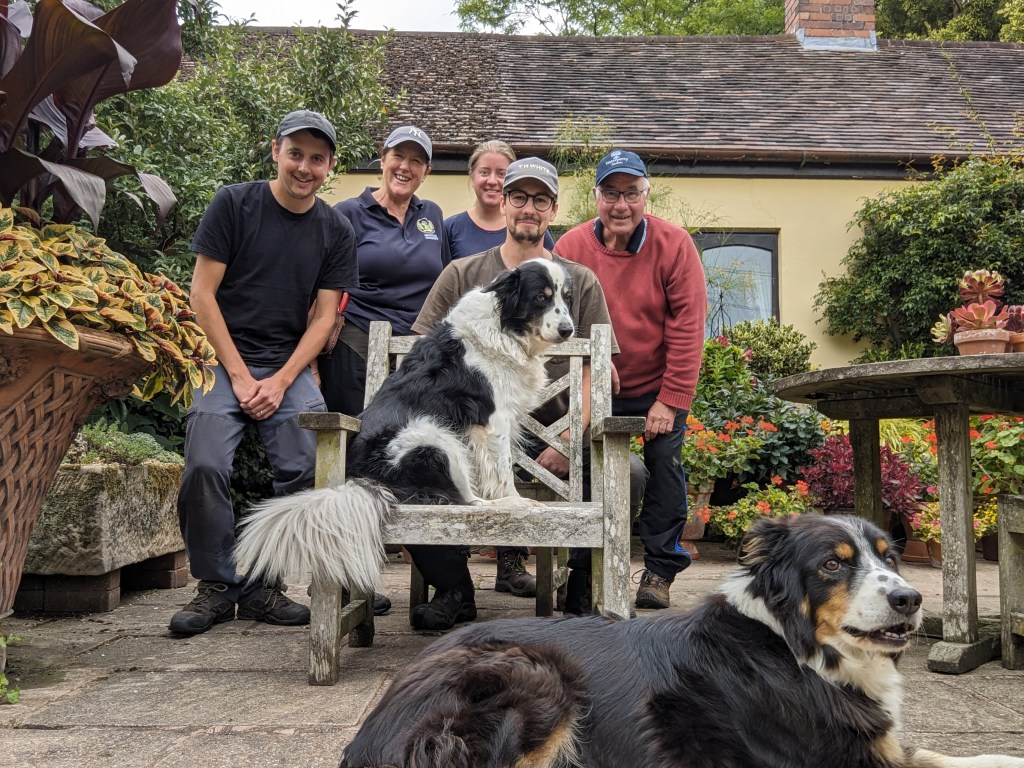
Me and the team on my last day